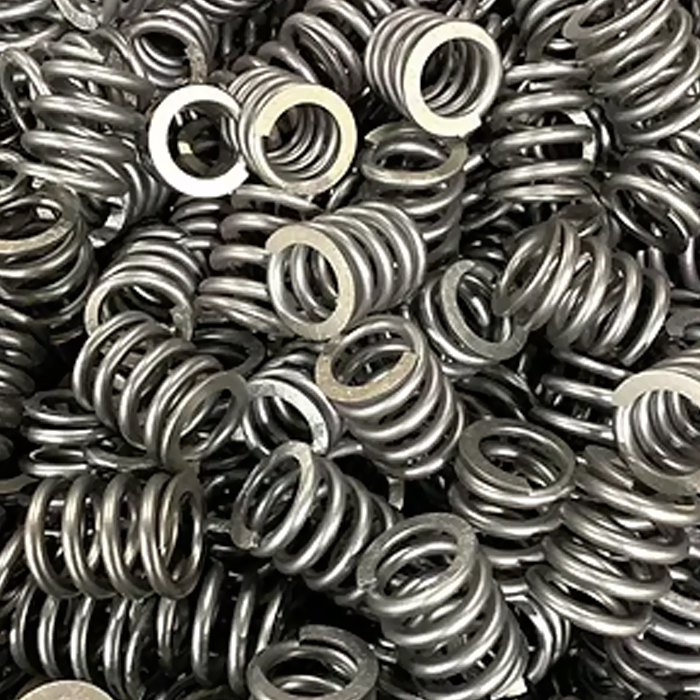
Compression Spring Manufacturing
We Manufacture Compression Springs Ranging from WD 0.3mm to 60 mm
By far the most widely used type of spring, compression springs are designed to oppose compression and return to its uncompressed length when the applied force is removed. The potential applications for compression springs are limited only by the imagination
These springs find a wide range of applications across various industries due to their versatility and reliability.
Dimensions Measurement Guide
- Hold the base of the spring in one hand, and the calipers on the other hand.
- Place the calipers on the outside of the last coil, measuring the largest dimension. This is called the Outside Diameter (O.D.).
- Place the calipers on the wire in the center of the spring. This is called the Wire or Material Size. You should also measure the wire toward one end for comparison and accuracy.
- Place the calipers on the full length of the uncompressed spring. This is called Free Length.
- Count the total coils, beginning at one end, just next to where the wire has been cut. Be sure you count all coils, including any portion of a coil. (see diagram for example)
Features of Compression Spring:
Design Versatility:
Compression springs come in a variety of designs, allowing for customization to meet specific requirements. Different wire diameters, coil pitches, and spring lengths can be tailored to achieve desired load capacities and spring rates.
Wide Range of Materials:
Compression springs can be manufactured from a variety of materials, including stainless steel, music wire, carbon steel, and more. Material selection depends on factors such as corrosion resistance, temperature resistance, and load-bearing capacity.
High Load Capacity:
Compression springs are designed to withstand high axial loads, making them suitable for applications where significant force needs to be absorbed or applied.
Energy Storage:
TWhen compressed, these springs store potential energy, which is released when the spring returns to its original form. This energy storage capability is useful in applications such as shock absorption and vibration dampening.
Durability:
Well-designed compression springs are built to withstand repeated cycles of compression and release without significant loss of performance or deformation.
Variety of End Configurations:
Compression springs can have different types of end configurations, such as open ends, closed and ground ends, or various types of loops or hooks, allowing for ease of attachment in different applications.
Service Life
It should be noted that if critical force-versus-deflection linearity is required, only the center 60-80% of the available deflection range should be employed. Thus, reserve at least the first and last 15-20% of the range for potential spring-end and adjacent coil-contact effects. These effects can be largely ignored for the majority of spring applications.
The “Suggest Maximum Deflection” used in our online and print catalog reflects the recommended inches of travel to obtain a statistical service-life of approximately 100,000 cycles(deflections) with infrequent breakage. This can be realized if the spring in question is not subjected to shock loads, rapid cycling, temperature extremes, corrosion, or stress values above those recommended. If the spring is statically loaded (not cycling), a near-infinite life can be expected. Extended spring service-life can be achieved through shot-peening. Our custom spring department can advise you regarding this procedure.
Materials
The highest grades of spring wire are used when fabricating our springs. To create cost-effective warehousing of our stock spring inventory for our customers, we offer material certification as custom springs only. Certifications of conformance for geometric tolerances set by the Spring Manufacturers Institute (SMI) are available for our stock springs upon request.
The term “spring steel” is a stock inventory term covering music wire, hard-drawn(MB) wire, and oil-tempered wire. Additionally, stock compression spring materials may include stainless steel (300 series), beryllium copper, and phosphor bronze.
Materials
Shama Spring manufactures our stock springs to commercial tolerances, as defined by the SMI. Calculated rates and loads based on SMI geometric tolerances have an approximate +/- 10%. Low or high-index springs will have higher values. Compression springs characteristically have an hourglass shape when coiled on an automatic coiler; therefore, outside/inside tolerance is applied to end coils only. This is an improvement consideration when selecting a spring that fits over a rod or inside a cylinder. Call us if tighter tolerance values are required for your application.
The direction of Helix (Wind)
The wind direction of our stock springs varies, both right-hand and left-hand wind. Stock springs are not sorted for wind direction. To order spring-wound a specific direction, please contact our custom spring division.
Ends Both the online catalog and the print version provide data on end configuration for our stock compression springs. Available configurations include:
- Closed (C) – The last coil at each end is bent back to touch the previous coil to create a flat base.
- Closed and Ground (C&G) – The closed ends of a spring are ground to a more accurate flat base. This also reduces the solid length.
- Open (O) – The spring end coils remain open, maintaining the spring machine’s helical wind shape.
Specifications of Compression Springs:
Wire Diameter:
This is the thickness of the wire used to create the coils of the spring. Thicker wires offer higher load-bearing capacities but can reduce the spring's flexibility.
Outer Diameter (OD):
The total diameter of the spring, including the coil diameter and the diameter of the wire itself.
Inner Diameter (ID):
The inner diameter of the spring, which is the difference between the outer diameter and twice the wire diameter.
Free Length:
This is the overall length of the spring when it's not under any compression.
Solid Height:
The height of the spring when it's fully compressed, i.e., when all coils are pressed tightly together.
Active Coils:
The number of coils that actively contribute to the spring's compression and expansion. This excludes the end coils that might be flat or inactive due to the spring's end configurations.
Spring Rate:
Also known as the stiffness coefficient, it indicates the amount of force required to compress the spring by a certain distance. It's usually measured in pounds per inch (lb/in) or Newtons per millimeter (N/mm).
End Configurations:
The type of end loops, hooks, or finishes can impact how the spring is attached or mounted in a given application.




